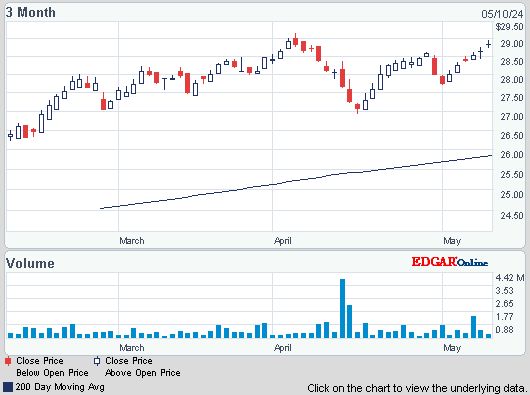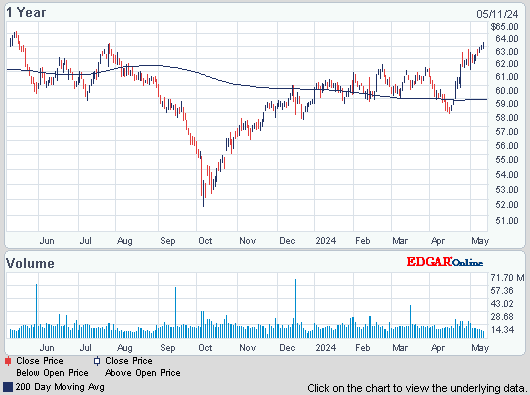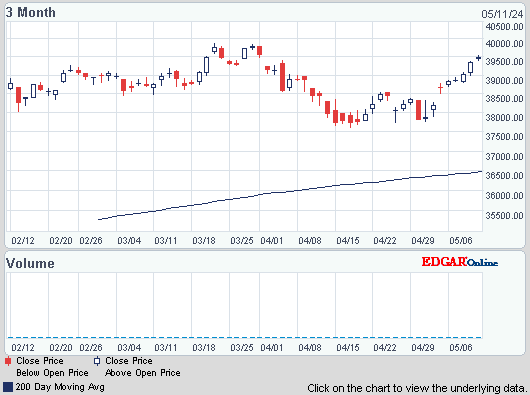Dow gained 73, advancers over decliners 3-1 & NAZ was up 19. The MLP index rebounded after yesterday's drop, up 4+ to the 448s, & the REIT index rose 3 to 296. Junk bond funds were higher & Treasuries saw some selling. Oil continued to sell off but gold recovered a little of yesterday's big loss.
AMJ (Alerian ML Index tracking fund)


Photo: Yahoo
Homebuilders in the US broke the 1M mark in Mar, the highest level since Jun 2008. signaling strength for the housing recovery at the start of the spring buying season. The overall pace of homes started rose 7% from Feb to Mar to a rate of 1.04M, according to the Commerce Dept. Apartment construction, which tends to fluctuate sharply from month to month, led the surge: by jumping 31% to an annual rate of 417K, the fastest pace in over 7 years. By contrast, single-family home building, which makes up nearly 2/3 of the market, fell 4.8% to an annual rate of 619K & was down from 650K in Feb. The Feb pace was 5.2% higher than it had previously estimated. Applications for building permits declined 3.9% to an annual rate of 902M. That was down from 939K in Feb, which was nearly a 5-year high.. In response to higher demand & a low supply of available homes for sale, builders have stepped up construction. The pace of homes started in Mar was 46% higher than in the same month in 2012. Construction firms have stepped up hiring in recent months by adding 18K jobs in Mar & 169K since Sep.
Housing Starts in U.S. Surge on Demand for Multifamily Units

Photo: Bloomberg
The IMF lowered its outlook for the world economy this year, predicting that gov spending cuts will slow US growth & keep the euro currency alliance in recession. It cut its forecast for global growth to 3.3% this year, down from its forecast in Jan of 3.5% but didn't alter its prediction of 4% global growth in 2014. The IMF expects the US economy to expand 1.9% this year, below the Jan estimate of 2.1% & last year's forecast of 2.2%. Still, the IMF says the US economy is improving & should expand 3% in 2014. Job growth has accelerated, the housing market is recovering & banks are more willing to lend. The IMF predicts that the 17-country eurozone will shrink 0.3% in 2013 & grow only 1.1% next year. Christine Lagarde, the managing director, said last week that the agenda for the meetings will include how to accelerate growth, create jobs & reform banking regulations. The IMF said worries about so-called "currency wars" are "overblown" because the world's major currencies aren't excessively undervalued or overvalued. The developing nations are expected to show the strongest growth over the next 2 years. China is forecast to expand 8% this year & 8.2% in 2014 to lead all nations. In its previous forecast, the IMF had predicted 8.1% growth this year & 8.5% in 2014. The US economy is projected to grow only modestly with higher taxes & spending cuts reducing growth by 1.75 percentage points, according to Olivier Blanchard, the IMF's chief economist. Given that drag, the IMF's 1.9% growth forecast for 2013 is better than it looks, he added. "Underlying private demand is actually strong," he said.
IMF Cuts Global Growth Outlook as Europe Demand Urged
Photo: Yahoo
Coca-Cola Profit Tops Estimates; Sells Some Bottling Rights

The bulls got the message yesterday about the market sell-off & returned after a long weekend. But economic fundamentals are pretty much the same highlighted by the US economy trudging along at a mediocre pace. The improvement in housing was due to apartment building while housing starts slid back More earnings along with Q1 GDP data will be coming to define where the markets want to go. Meanwhile, Apple (AAPL), with the largest market cap in the world, is up 2 to 422, down almost 300 from last year's high. That's a major disconnect with Dow near a record high.
Dow Jones Industrials

AMJ (Alerian ML Index tracking fund)
Treasury yields:
U.S. 3-month |
0.058% | |
U.S. 2-year |
0.224% | |
U.S. 10-year |
1.720% |
| CLU13.NYM | ...Crude Oil Sep 13 | ...89.05 | (0.4%) |
| GCJ13.CMX | ....Gold Apr 13 | .....1,381.80 | (1.6%) |

Photo: Yahoo
Homebuilders in the US broke the 1M mark in Mar, the highest level since Jun 2008. signaling strength for the housing recovery at the start of the spring buying season. The overall pace of homes started rose 7% from Feb to Mar to a rate of 1.04M, according to the Commerce Dept. Apartment construction, which tends to fluctuate sharply from month to month, led the surge: by jumping 31% to an annual rate of 417K, the fastest pace in over 7 years. By contrast, single-family home building, which makes up nearly 2/3 of the market, fell 4.8% to an annual rate of 619K & was down from 650K in Feb. The Feb pace was 5.2% higher than it had previously estimated. Applications for building permits declined 3.9% to an annual rate of 902M. That was down from 939K in Feb, which was nearly a 5-year high.. In response to higher demand & a low supply of available homes for sale, builders have stepped up construction. The pace of homes started in Mar was 46% higher than in the same month in 2012. Construction firms have stepped up hiring in recent months by adding 18K jobs in Mar & 169K since Sep.
Housing Starts in U.S. Surge on Demand for Multifamily Units

Photo: Bloomberg
The IMF lowered its outlook for the world economy this year, predicting that gov spending cuts will slow US growth & keep the euro currency alliance in recession. It cut its forecast for global growth to 3.3% this year, down from its forecast in Jan of 3.5% but didn't alter its prediction of 4% global growth in 2014. The IMF expects the US economy to expand 1.9% this year, below the Jan estimate of 2.1% & last year's forecast of 2.2%. Still, the IMF says the US economy is improving & should expand 3% in 2014. Job growth has accelerated, the housing market is recovering & banks are more willing to lend. The IMF predicts that the 17-country eurozone will shrink 0.3% in 2013 & grow only 1.1% next year. Christine Lagarde, the managing director, said last week that the agenda for the meetings will include how to accelerate growth, create jobs & reform banking regulations. The IMF said worries about so-called "currency wars" are "overblown" because the world's major currencies aren't excessively undervalued or overvalued. The developing nations are expected to show the strongest growth over the next 2 years. China is forecast to expand 8% this year & 8.2% in 2014 to lead all nations. In its previous forecast, the IMF had predicted 8.1% growth this year & 8.5% in 2014. The US economy is projected to grow only modestly with higher taxes & spending cuts reducing growth by 1.75 percentage points, according to Olivier Blanchard, the IMF's chief economist. Given that drag, the IMF's 1.9% growth forecast for 2013 is better than it looks, he added. "Underlying private demand is actually strong," he said.
IMF Cuts Global Growth Outlook as Europe Demand Urged
Photo: Yahoo
Coca-Cola, a Dow stock & Dividend Aristocrat, reported Q1 earnings that exceeded
expectations, boosted by a rise in sales in Europe & emerging markets. EPS excluding items were 46¢, versus 45¢ last year. Revenue, however, dipped to $11.04B,
from $11.14B a year ago. Expected
were for EPS of 45¢ on $10.94B in
revenue. It had strong growth volume in regions that
included Thailand, India, Russia, Mexico & Brazil, but saw more
modest growth in China & the US, where volumes rose by 1%
in each market. Total case volumes rose 4%, led by a 15% surge in its Eurasia & Africa business. "I am pleased with our first quarter performance results, having once
again delivered solid growth against the backdrop of a still uncertain
global economy," said CEO Muhtar Kent. He added that the company was "on track" to meet its goals
for the year 2020. The stock shot up 2.02 to 42.11..
Coca-Cola Profit Tops Estimates; Sells Some Bottling Rights
Coca-Cola (KO)
The bulls got the message yesterday about the market sell-off & returned after a long weekend. But economic fundamentals are pretty much the same highlighted by the US economy trudging along at a mediocre pace. The improvement in housing was due to apartment building while housing starts slid back More earnings along with Q1 GDP data will be coming to define where the markets want to go. Meanwhile, Apple (AAPL), with the largest market cap in the world, is up 2 to 422, down almost 300 from last year's high. That's a major disconnect with Dow near a record high.
Dow Jones Industrials











No comments:
Post a Comment